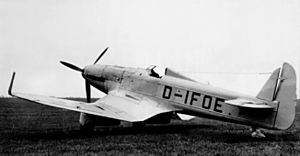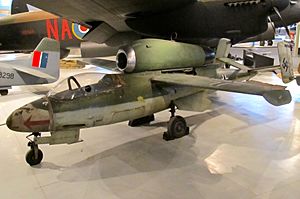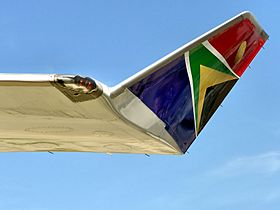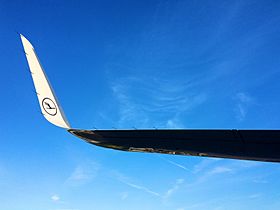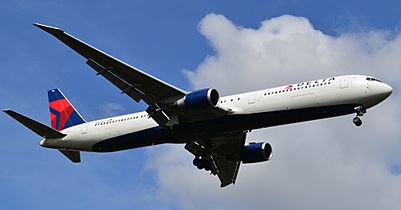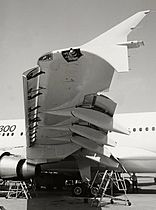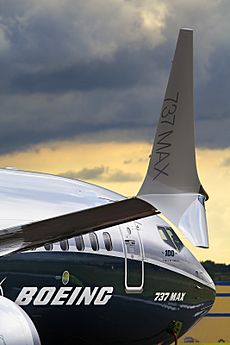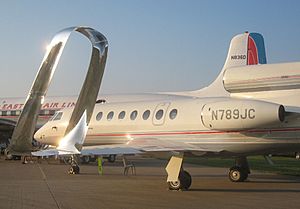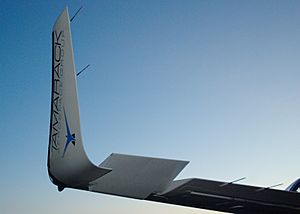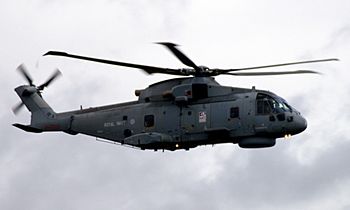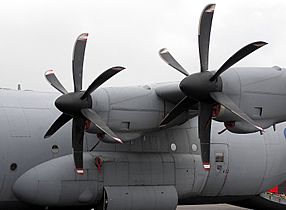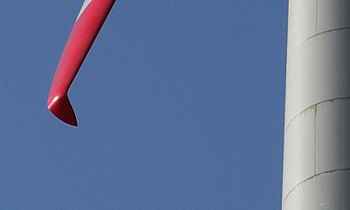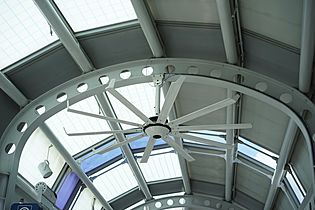Wingtip device facts for kids

Wingtip devices are special parts on the ends of airplane wings. Their main job is to make planes fly better by reducing something called drag. Drag is a force that pulls the plane backward and makes it use more fuel. There are different kinds of wingtip devices, but they all aim to cut down on this drag.
These devices also help planes handle better and make the sky safer for other aircraft flying behind them. They make a wing act like it's longer without actually making the wingspan much bigger. A longer wing helps reduce drag, but it also makes the wing heavier and harder to fit at airports. Wingtip devices solve this problem by giving the benefits of a longer wing without the extra size or weight.
Wingtip devices work by stopping high-pressure air from under the wing from swirling over to the low-pressure area on top of the wing. This swirling air creates a mini-tornado called a wingtip vortex. These vortices cause drag. By reducing these vortices, wingtip devices help the plane glide more efficiently. This means planes use less fuel, which saves money and is better for the environment. For gliders, it means they can fly faster and farther.
Contents
How Did Wingtip Devices Start?
Early Ideas
The idea for wingtip devices goes way back to 1897! An English engineer named Frederick W. Lanchester first thought of using "end-plates" on wings to control those swirling air currents. Later, in 1910, an engineer from Scotland, William E. Somerville, created the first working winglets in the United States. He put them on his early planes.
At first, simple flat end-plates didn't work well. They created more drag than they saved.
Hoerner Tips
After World War II, a scientist named Dr. Sighard F. Hoerner suggested using wingtips that drooped downwards. These "Hoerner tips" helped push the swirling air away from the top of the wing. Many gliders and small planes have used Hoerner tips for a long time.
One of the first times a jet plane used a Hoerner-style wingtip was during World War II. These were called "Lippisch-Ohren" (Lippisch-ears) and were added to the Heinkel He 162 jet fighter. They helped fix a problem with how the plane flew, making it more stable.
What Are Winglets?
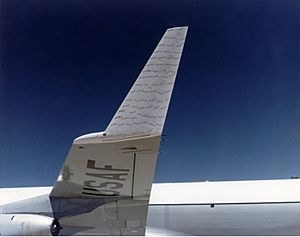
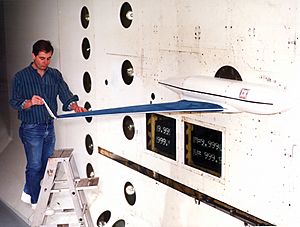
The word "winglet" became popular in the 1970s thanks to Richard T. Whitcomb at NASA. He used it to describe the almost-vertical parts that stick up from the ends of wings. The way a winglet is angled (up, in, or out), its size, and its shape are very important for it to work correctly. Each plane needs a unique design.
Winglets work by catching the swirling air from under the wing. This creates a small forward push, like a sailboat sailing into the wind. This tiny push might not seem like much, but over the lifetime of an airplane, it saves a lot of fuel!
Another great thing about winglets is that they make the swirling air behind the plane less strong. These "wake vortices" can be dangerous for other planes flying behind, so air traffic controllers have to keep planes far apart. Winglets help reduce this danger, which can make airports safer and allow planes to take off more often.
Winglets also make the airflow over the wing smoother near the tips. This helps the wing create more lift in that area. Planes like the Airbus A340 and the Boeing 747-400 use winglets. Other planes, like the Boeing 777 and Boeing 747-8, use a different design called "raked wingtips." Winglets are especially good for saving fuel on long flights. They can also help planes take off in shorter distances.
How Winglets Were Developed
Richard T. Whitcomb at NASA worked on winglets after the price of fuel went up a lot in the 1970s. He showed that a winglet sticking almost straight up could reduce drag more than just making the wing longer. NASA and the Air Force tested his designs in 1979–80 on a KC-135 Stratotanker plane. The McDonnell Douglas DC-10 also used these ideas for its newer version, the MD-11, which came out in 1990.
In 1983, a high school student even won a science fair prize for his research on wingtip devices!
Where Are Winglets Used?
Business Jets
The Learjet 28 was the first commercial plane to use winglets in 1977. Learjet designed them without NASA's help. Tests showed that winglets increased the plane's range by about 6.5% and made it more stable. Many other Learjet models, like the Learjet 55 and Learjet 60, also use winglets.
Gulfstream Aerospace also started using winglets in the late 1970s on planes like the Gulfstream III and Gulfstream V. The Gulfstream V can fly over 6,500 nautical miles (about 12,000 km) without stopping, making long flights possible, like New York to Tokyo.
Winglets are also used on other business jets to help them take off from smaller airports and fly higher.
Airliner Fuel Savings
On average, large passenger jets can save 4-6% on fuel and reduce noise by up to 6% when they use winglets. This means less carbon pollution too! The exact savings depend on the plane, the route, and the weather.
Wingtip Fence
A "wingtip fence" is a type of winglet that has parts extending both above and below the wingtip. Both parts are usually shorter than a typical winglet. The Airbus A310-300 was the first airliner to use wingtip fences in 1985. Other Airbus planes, like the A320ceo and A380, also use them. However, newer Airbus planes like the Airbus A320 Enhanced, A320neo, A350, and A330neo use "blended winglets" instead.
Canted Winglets
Boeing introduced a new version of the 747, the 747-400, in 1985. It used winglets that were angled, or "canted," along with a slightly longer wing. These winglets increased the 747-400's range by 3.5% compared to the older 747-300. Boeing often uses winglets on updated versions of their existing planes.
The Ilyushin Il-96 was the first modern Russian jet with winglets in 1988. The Bombardier CRJ-100/200 was the first regional jet with winglets in 1992. The A340/A330 followed in 1993/1994.
Blended Winglets
A "blended winglet" connects to the wing with a smooth curve instead of a sharp corner. This smooth connection helps reduce drag where the wing meets the winglet. Companies like Aviation Partners in Seattle create blended winglets for planes like the Gulfstream II and Hawker 800.
-
Boeing 747-400 canted winglet
-
Airbus A320 sharklet
-
Boeing 767-400ER with raked wingtips
-
Airbus A310-300 wingtip fence
Blended winglets became an option for the Boeing 737-800 in 2000. These 8-foot (2.4-meter) extensions can cut fuel use by 4% on long flights and increase range by 130 to 200 nautical miles (240 to 370 km). Many older 737s have been updated with these winglets to save fuel.
In 2009, Airbus launched its "Sharklet" blended winglet for its A320 family planes. These Sharklets improve how far the plane can fly with a certain weight and reduce fuel burn by up to 4% on longer flights. This saves about 700 tons of CO2 per plane each year! Sharklets are used on the A320neo, A330neo, and A350.
Raked Wingtips
"Raked wingtips" are wingtips that sweep back more sharply than the rest of the wing. Boeing uses them on some of its planes to save fuel and improve takeoff and climb. Like winglets, they make the wing act longer and reduce those swirling air currents. Tests show they can reduce drag by up to 5.5%, which is even better than some traditional winglets.
Raked wingtips are on planes like the Boeing 767-400ER, the Boeing 777-200LR/300ER/Freighter, the Boeing 787, the Boeing 747-8, and the Boeing 777X. The Embraer E-jet E2 also has raked wingtips.
Split-Tip Winglets
The McDonnell Douglas MD-11 was the first plane with "split-tip winglets" in 1990.
For the 737 Next Generation, Aviation Partners Boeing created a similar design called the Split Scimitar Winglet. This design is like a mix of a winglet, a wingtip fence, and a raked wingtip. Boeing says this new design gives an extra 1.5% fuel saving on top of the 10-12% already expected from the Boeing 737 MAX.
Gliders
In 1987, an engineer named Peter Masak worked with a professor, Mark D. Maughmer, to design winglets for his racing sailplane. While earlier attempts at glider winglets helped with climbing, they slowed the glider down too much at high speeds. Masak believed they could do better.
After many tries, they created successful winglets for gliding competitions. At the 1991 World Gliding Championships, a glider with their winglets won for the highest speed in its class, even beating the fastest glider in the unlimited class! This was a huge achievement.

Within 10 years, most high-performance gliders were built with winglets. Even a tiny improvement in efficiency can make a big difference in gliding competitions. Many pilots also added winglets to their gliders because they made the glider easier to control and less likely to stall at the wingtips.
Other Types of Wingtip Devices
Non-Planar Wingtips
"Non-planar wingtips" are angled upwards, making the wing more like a bent shape near the tip. They help control the swirling air like winglets but can create less drag if designed carefully. These tips are often swept back, similar to raked wingtips, and can even be combined with a winglet.
After winglets became popular, designers started looking at how to make the connection between the wing and the winglet even better. They began to smoothly taper the wingtip and angle it upwards, sometimes even getting rid of the separate winglet entirely.
The Schempp-Hirth Discus-2 and Schempp-Hirth Duo Discus gliders use non-planar wingtips.
Active Wingtip Devices
A company called Tamarack Aerospace Group has created an "Active Technology Load Alleviation System" (ATLAS). This system uses movable panels on the wingtip, like small flaps. When the plane hits a strong gust of wind or makes a sharp turn, these panels move to "switch off" the effects of the wingtip device. This helps reduce stress on the wing. The system is controlled by the plane's computer and fast motors. Tamarack first used ATLAS on Cessna Citation family planes.
Moving Wingtip Devices
There has been research into wingtip devices that can actually move during flight. For example, the XB-70 Valkyrie bomber had wingtips that could droop downwards during very fast flights (Mach 3). This helped the plane fly more efficiently at high speeds.
Wingtip Devices on Other Things
Wingtip devices aren't just for airplane wings! They are also used on spinning parts like propellers, helicopter rotor blades, and wind turbine blades. They help reduce drag, make the blades quieter, and improve efficiency. For helicopters, they can also reduce the amount of dirt and stones kicked up by the swirling air near the ground.
Helicopter Blades
The main rotor blades of the AgustaWestland AW101 helicopter have a unique tip shape. Pilots have found that this design helps reduce "brownout," which is when dust and sand get kicked up and make it hard to see, especially in dusty areas.
Propellers
Hartzell Propeller developed "Q-tip" propellers that bend the blade tips back at a 90-degree angle. This allows them to get the same power from a smaller propeller, which also makes them quieter. Modern "scimitar propellers" have tips that sweep back, looking like the raked wingtips on an airplane.
Other Uses
Some ceiling fans even have wingtip devices to make them more efficient! The same idea was also used on the keel (the bottom part) of the "America's Cup"-winning yacht Australia II in 1982.
See also
 In Spanish: Dispositivo de punta alar para niños
In Spanish: Dispositivo de punta alar para niños



